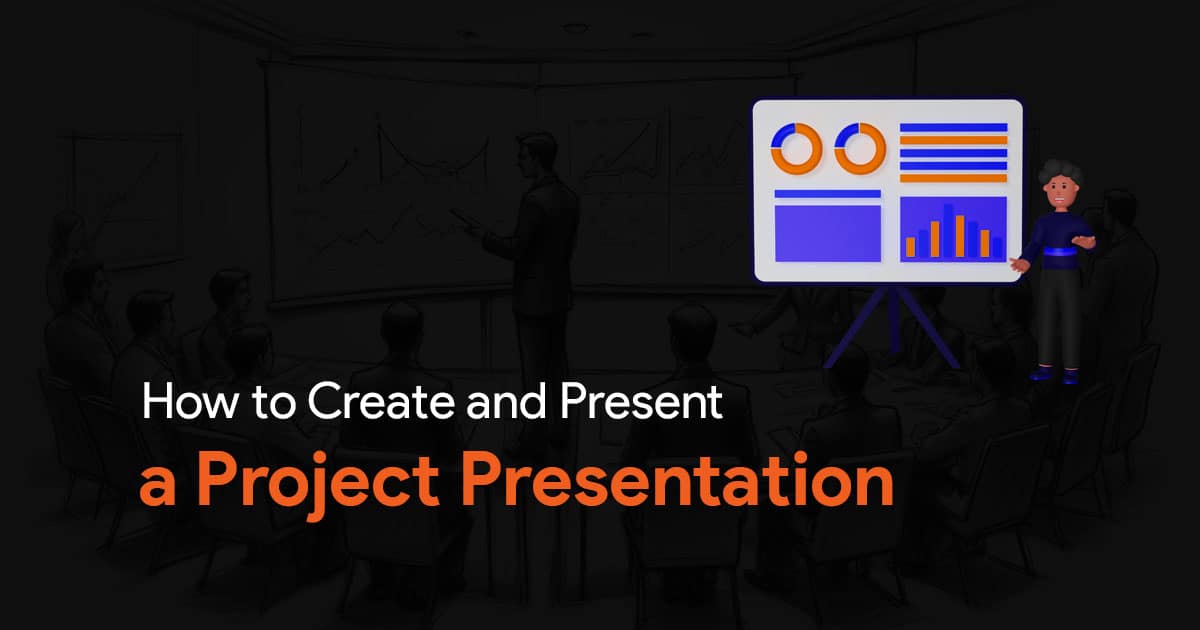How to Create and Present a Project Presentation

Knowing how to deliver a successful project presentation is a must have skill for professionals, whether in corporate, academic or business settings. It is more than just sharing a slideshow and information. To get success, you must know how to craft a compelling narrative that effectively conveys your ideas and plans. In this article, I will provide insights on how you can create and deliver memorable project presentations. Keep reading to learn more!
What is a Project Presentation?
A project presentation is a formal activity where stakeholders and team members gather to review and oversee the project from initiation to completion. It involves presenting a slide deck, that outlines the project’s key details.
So how do you ensure you create a successful project presentation? Follow these steps:
1. Understand Your Audience
Even before you start crafting your presentation, first take a moment to think about your audience. Who are they? What do they know about your topic? What are their interests and concerns? No matter the type of presentation you are about to create, tailoring your presentation to your audience’s needs will make it more relevant and engaging.
The audience can include team members who will work on the project who need detailed information about the requirements, roadmap, work breakdown structure and deliverables. And of course, it will also include the project stakeholders who authorize resources and expenses. Stakeholders need details on the project scope, budget, timing, risk assessments, and how you plan to address those risks. Think of all this before you head out to start creating your presentation.
2. Now Define Your Objective
Think about the main goal of your presentation. Are you trying to inform, persuade, or motivate your audience? A clear objective will guide the content and structure of your presentation. While creating your presentation, make sure every part of your presentation aligns with this objective.
3. Structure Your Presentation
Your presentation must be well structured, as a well structured presentation is much easier to follow. Generally your presentation must contain the following elements:
- Introduction: Start with a hook to grab your audience’s attention. This catches the audience’s interest and makes them curious to know what’s coming next. Introduce yourself and outline the topics you will cover in the presentation.
- Main Content: Next, in the main content, divide the content into clear, logical sections. Each section should cover a key point or idea.
- Conclusion: Summarize the main points of your presentation, restate your objective, and end with a strong closing statement to make your presentation memorable.
Talking about structure, here’s what your slideshow must contain the following:
Executive Summary
First of all start with an executive summary to introduce the presentation and provide context. Learn more about executive summaries in this article here.
Project Overview
Next up, provide a brief background about your project, its objectives, and goals. Include a quick overview of the timeline with start and end dates. Find timeline templates for your presentation here.
The Project Process Model
Talk about the chosen project process model, such as Waterfall, Scrum, or Business Process Modeling Notation (BPMN). Explain how it will guide all the activities through the project lifecycle.
The Project Scope
Discuss the project scope, including requirements gathering, work breakdown structure, and scope management plans.
The Project Resources
Present a budget breakdown next. Tailor this section to your specific industry.
The Project Roadmap
You can use visual layouts to present the project roadmap, highlighting milestones and time estimates for your project. For ongoing projects, mark the current progress on the roadmap. To get started with this, check out some of these roadmap presentation templates.
The Project Activities Plan
After that, you can detail the project activities plan using a Gantt Chart and Costs Report. Break down each phase into specific tasks, their duration, and allocated resources.
The Project Risks
In the next section you can dedicate a few slides to identify, assess, evaluate, and mitigate project risks. Visualize your risk assessment with a risk matrix and explain your mitigation strategies.
Quality Control
Outline the quality control techniques you will use, such as Six Sigma, ISO 9000, or Total Quality Management (TQM) and include a slide to visualize the quality control process. You can do so very easily with templates found on our website.
Project Execution and Monitoring
Explain how you are going to monitor activities and measure deliverable outcomes. Use dashboards to present progress reports, performance KPIs, and status updates.
The Project Team
Include a stakeholder map or org chart to introduce the management team, sponsors, main stakeholders, and implementation teams. Provide background on each person’s role in the project. To get started, check out some of these org chart presentation templates.
Tips For a Successful Project Presentation
Create Engaging Content
First and foremost, your content should be clear, concise, and engaging. You do not want your audience to lose interest during your presentations, especially during something as important as a project presentation. Here are some tips to help you create content that captivates your audience:
- Tell a Story: Use storytelling techniques to make your points more relatable and memorable.
- Use Visuals: Use less text and more visual aids like slides, charts, and images can help illustrate your points and keep your audience engaged. Make sure your visuals are high-quality and relevant to your content.
- Include Data: Data and statistics can add credibility to your presentation. So make sure to use them to back up your points. But do not overuse them and overwhelm your audience with too much information.
Pay Attention to Slide Design
Your slides should complement your presentation, not distract from it. Here are some design tips:
- Keep it Simple: Use a clean, consistent layout. Avoid clutter and unnecessary elements.
- Limit Text: Use only a few words on your slides. You are not supposed to read aloud your slides. Your slides are only supposed to support your presentation.
- Limit Fonts: Stick to 2 fonts, and use them throughout your presentation for a consistent look.
Practice, Practice, Practice
Practice is key to a successful presentation. Make sure you create your slides well ahead of time to make more time for rehearsals. You can make slides a lot faster simply by using presentation templates instead of creating slides from scratch.
Rehearse your presentation multiple times to become familiar with the content and flow. Practice in front of a mirror, record yourself, or present to a friend for feedback.
Prepare for Questions
Always be ready for questions from your audience. Think about potential questions and prepare your answers. This will help you with confidence, and you’ll be able to answer any question easily.
Conclusion
Creating and presenting a successful project presentation is an art that combines clear communication, engaging content, and confident delivery. By following these steps and continually refining your skills, you can deliver presentations that inform, persuade, and inspire your audience. Happy presenting!


